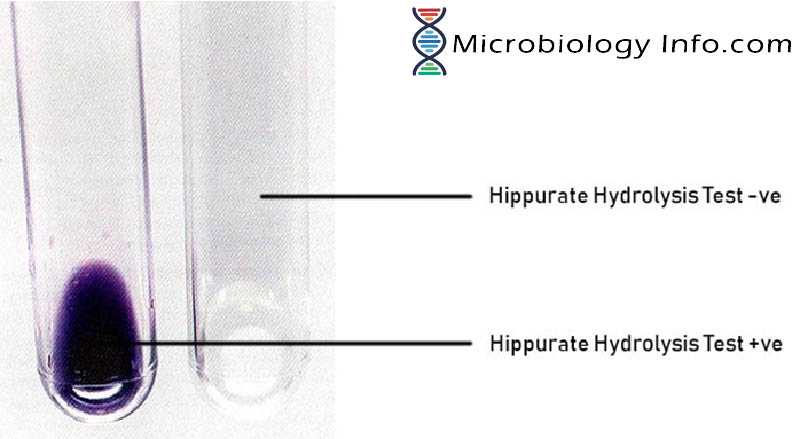Hippurate hydrolysis test is used to detect the ability of bacteria to hydrolyse substrate hippurate into glycine and benzoic acid by action of hippuricase enzyme present in bacteria.
Hippuricase is a constitutive enzyme that hydrolyzes the substrate hippurate to produce the amino acid glycine. Glycine is detected by oxidation with Ninhydrin reagent, which results in the production of a deep purple color.
Hippurate hydrolysis test is used in the presumptive identification of Gardnerella vaginalis, Campylobacter jejuni, Listeria monocytogenes and group B streptococci by detecting the ability of the organism to hydrolyze hippurate.
Objective
To detect the production of the enzyme hippuricase for the presumptive identification of a variety of microorganisms.
Principle
Hippurate is the glycine conjugate of benzoic acid. When hippurate is hydrolysed by an organism glycine and benzoic acid are formed. Glycine is deaminated by the oxidizing agent ninhydrin, which is reduced during the process. The end products of the ninhydrin oxidation react to form a purple-colored product.
Method
- Add 0.1 mL of sterile water to a 12 ×75 mm plastic test tube.
- Make a heavy suspension of the organism to be tested.
- Using heated forceps, place a rapid hippurate disk in the mixture.
- Cap and incubate the tube for 2 hours at 35°C; use of a water bath is preferred.
- Add 0.2 mL ninhydrin reagent and reincubate for an additional 15 to 30 minutes.
- Observe the solution for the development of a deep purple color.
Expected Results
- Positive: A positive test is indicated by the appearance of a deep blue/violet color in 30 minutes.
- Negative: Colorless or slightly yellow pink color
Uses
- The hippurate test is most frequently used in the identification of Gardnerella vaginalis, Streptococcus agalactiae, Campylobacter jejuni, and Listeria monocytogenes.
- Used in the differentiation of β-hemolytic Streptococcus agalactiae from other β-hemolytic streptococci.
- Aids in the separation of Campylobacter jejuni and Campylobacter coli strains.
Limitations
- A false-positive result may occur if incubation with ninhydrin exceeds 30 minutes.
- The test medium must contain only hippurate, because ninhydrin might react with any free amino acids present in growth media or other broths.
- Hippurate hydrolysis is also found in some species of other genera, such as Bacillus, Corneybacterium, Enterobacteriaceae, and others.
- The hippurate solution deteriorates in 7 days at 4°C.
- The ninhydrin solution deteriorates in 6 months.
- It is recommended that biochemical, immunological, molecular, or mass spectrometry testing be performed on colonies from pure culture for complete identification.
- Insufficient inoculum may result in erroneous results.
References
- Tille, P. M., & Forbes, B. A. (2014). Bailey & Scott’s diagnostic microbiology (Thirteenth edition.). St. Louis, Missouri: Elsevier.
- https://catalog.hardydiagnostics.com/cp_prod/content/hugo/HippurateTest.htm
- himedialabs.com/td/dd035.pdf

